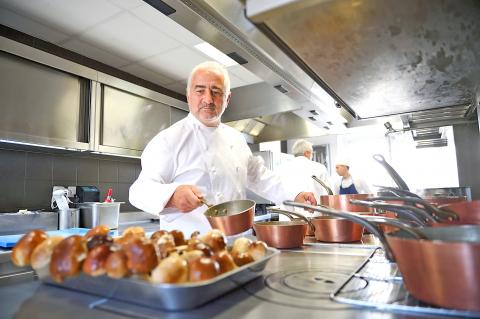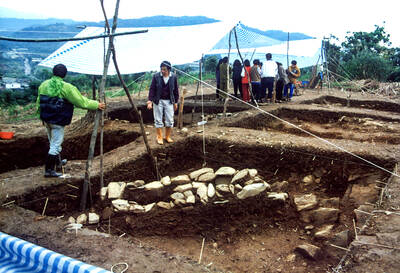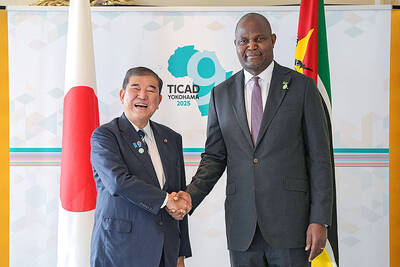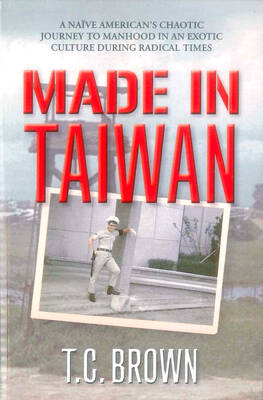Japan and China have more of the world’s best restaurants than anywhere else, according to the La Liste ranking, which will be published next week.
Although the French-based list will declare Guy Savoy’s flagship Paris riverside restaurant the best in the world for the second year running — and French cooking dominates the top 100 — the big trend is the climb of Chinese haute cuisine.
“The rise and rise of China is the big story,” said Jorg Zipprick, who crunched the numbers for the “guide of guides,” which was set up as a “more scientific and reliable” rival three years ago to the British-based 50 Best Restaurants.

Photo: AFP
Japan still tops the country table with 138 restaurants in the top 1,000 of the French classification — which aggregates reviews from guides, newspapers and Web sites including TripAdvisor — but China is closing the gap fast with 123.
“Up to now China has been one of the most difficult countries to get data from,” Zipprick said, but a boom in local gastronomic guides has changed all that.
“Asia has a lot more restaurants than Europe and it is only logical that La Liste will reflect that,” he added.
MAO’S FAVORITE DISH
Tokyo institution Kyubey, whose sushi is renowned for being both “extraordinary and reasonably priced,” took third spot after Le Bernardin, a New York fish restaurant run by Emmy award-winning US television chef Eric Ripert.
Two other restaurants in the Japanese capital made the top 20, the minuscule Kyo Aji and French chef Joel Robuchon’s plush dining room in a reconstructed French chateau.
They were followed by the highest-placed Chinese restaurant, the Huai Yang Fu at Andingmen in Beijing — whose specialty is a roast pork dish adored by Chairman Mao.
While there is no dramatic change at the summit of the list, there were three newcomers to the top 10, including The French Laundry, a former saloon in California’s Napa Valley, which Kitchen Confidential author Anthony Bourdain has called “the best restaurant in the world, period.”
It shared an almost perfect mark of 99 out of 100 with La Vague d’Or in the French Riviera resort of Saint Tropez and Martin Berasategui’s restaurant in the village of Lasarte in Spain’s Basque country.
PLANKTON SORBET
Another of the big climbers was Aponiente at the other end of Spain, where diners cleanse their palates with a plankton sorbet.
The Andalusian fish specialist in El Puerto de Santa Maria jumped 200 places on the back of getting a third Michelin star.
For the first time a Canadian restaurant, Alo in Toronto, has entered the top 100, while the Turkish female chef Aylin Yazicioglu makes the grade for her highly-rated Istanbul restaurant, Nicole.
New York’s Eleven Madison Park, which was first in the 50 Best Restaurants ranking in 2017, made the top five of La Liste. But the two lists differ widely beyond that — although they roughly agree that El Celler de Can Roca in Girona, Spain; Osteria Francescana in Modena, Italy, as well Alain Ducasse and Le Bernardin represent more or less the summit of the culinary arts.
La Liste’s aggregator of the 1,000 top-rated restaurants in the world is modeled on the world tennis rankings and the Shanghai Ranking for universities. While Japan, China, France and the US top the league for having the highest number of best restaurants, Switzerland with 38 for a population of eight million, has the highest per capital rating.
Zipprick said its database — which is available as a smartphone app — now includes 16,000 eateries across the world which it classifies from haute cuisine to lower-priced “Food Gems.”
Superstar chef Gordon Ramsay’s flagship London restaurant remained the highest-rated British table, pipping L’Enclume, which operates in a former blacksmith’s forge in Cumbria, northwest England.
This year’s winners will be formally announced at a banquet in Paris on Monday, with 40 of the world’s leading chefs also invited to meet French President Emmanuel Macron at his Elysee Palace residence.

Aug. 25 to Aug. 31 Although Mr. Lin (林) had been married to his Japanese wife for a decade, their union was never legally recognized — and even their daughter was officially deemed illegitimate. During the first half of Japanese rule in Taiwan, only marriages between Japanese men and Taiwanese women were valid, unless the Taiwanese husband formally joined a Japanese household. In 1920, Lin took his frustrations directly to the Ministry of Home Affairs: “Since Japan took possession of Taiwan, we have obeyed the government’s directives and committed ourselves to breaking old Qing-era customs. Yet ... our marriages remain unrecognized,

During the Metal Ages, prior to the arrival of the Dutch and Chinese, a great shift took place in indigenous material culture. Glass and agate beads, introduced after 400BC, completely replaced Taiwanese nephrite (jade) as the ornamental materials of choice, anthropologist Liu Jiun-Yu (劉俊昱) of the University of Washington wrote in a 2023 article. He added of the island’s modern indigenous peoples: “They are the descendants of prehistoric Formosans but have no nephrite-using cultures.” Moderns squint at that dynamic era of trade and cultural change through the mutually supporting lenses of later settler-colonialism and imperial power, which treated the indigenous as

An attempt to promote friendship between Japan and countries in Africa has transformed into a xenophobic row about migration after inaccurate media reports suggested the scheme would lead to a “flood of immigrants.” The controversy erupted after the Japan International Cooperation Agency, or JICA, said this month it had designated four Japanese cities as “Africa hometowns” for partner countries in Africa: Mozambique, Nigeria, Ghana and Tanzania. The program, announced at the end of an international conference on African development in Yokohama, will involve personnel exchanges and events to foster closer ties between the four regional Japanese cities — Imabari, Kisarazu, Sanjo and

By 1971, heroin and opium use among US troops fighting in Vietnam had reached epidemic proportions, with 42 percent of American servicemen saying they’d tried opioids at least once and around 20 percent claiming some level of addiction, according to the US Department of Defense. Though heroin use by US troops has been little discussed in the context of Taiwan, these and other drugs — produced in part by rogue Chinese Nationalist Party (KMT) armies then in Thailand and Myanmar — also spread to US military bases on the island, where soldiers were often stoned or high. American military policeman